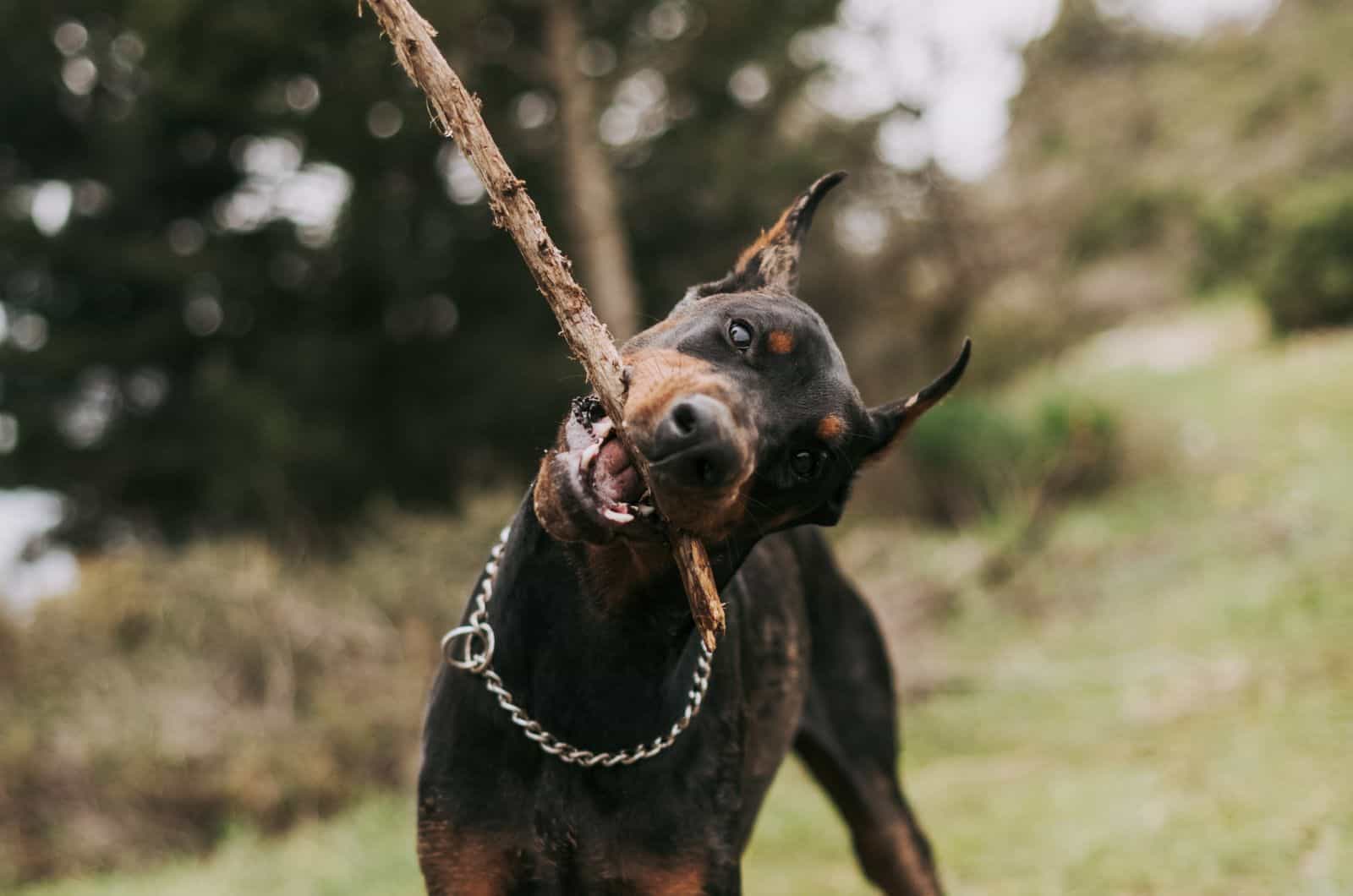We all know that dogs love sticks, whether it’s chasing after them when we throw them or taking one from the ground and bringing it back with them, but why do dogs like sticks?
Well, the simplest answer to the question of “Why do dogs like sticks?” is that we’ve bred them for that very specific reason way back in the past, and it just carried over as something natural nowadays.
However, it’s not just that, there are plenty of other reasons, their tastes and smells being one of them as is their relatability to being a makeshift chew toy for your precious pooch.
After all, dogs of yore didn’t really have access to all the fancy toys nowadays so they’d pick up sticks, nature’s dog toy, and both the dogs and their owners would use this very simple object in a variety of innovative ways to create their own fun.
Finding the perfect stick for a game of fetch wasn’t all too uncommon back in the day.
It may surprise you to learn that chewing on sticks helps to clean the dog’s teeth as well and to provide other dental benefits like relief when teething or when they feel any pain in their gums or teeth in general.
That prey drive is key, however, one that’s been nurtured to breed quality hunting dogs, shepherds and retrievers that we all know and love, and all that was needed was a good stick and a lot of training.
But, there are a few bad sides to sticks too, hazards that are always a possibility and that one needs to be careful of like accidental injury or consumption of said stick.
To find out all of the reasons as to why a dog loves to chew sticks and some of the hazards tied to such behavior, be sure to read on.
10 Interesting Answers To The Question Of “Why Do Dogs Like Sticks”
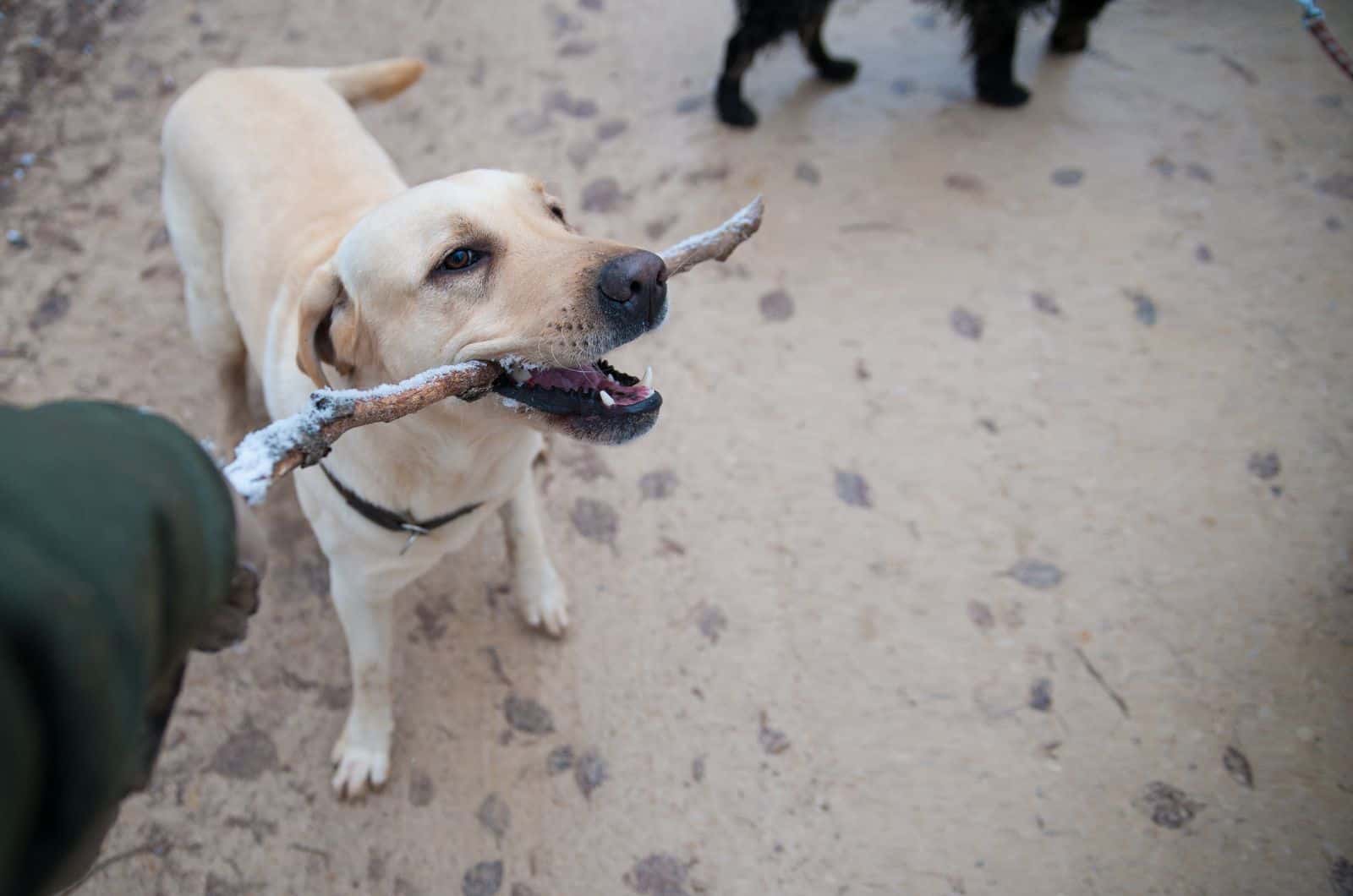
1. Nature’s Best Toy
The first reason that comes to mind to any person who may have thought about this question is that they use it as a toy, and they’d be completely right.
Dogs love to chase after things due to their prey drive which is present in every dog breed, albeit in different amounts, though they are all equally crazy for the stick.
Again, it was one of the most accessible toys around back when dogs first started getting domesticated, and were thus used as both a training tool and a recreational one.
Sure, leather balls were developed later, but not everyone had one, and they weren’t mass manufactured.
And, if a dog considers something a toy, he’ll be able to derive a lot of fun from it, which would be the case here.
Whether you use it as a fetch toy or the dog just uses it as a chew toy to pass the time, or a mix of the two, that’s completely up to you two.
2. Chewing Is A Great Source Of Stress Relief
You know how chewing gum helps us humans de-stress, or how food can sometimes make you feel more at ease?
That’s all because of chewing, and it applies to every living animal who practices the act.
Chewing something constantly helps release endorphins which, in turn, help the body relax and have it believe it has no need to be tense or anxious.
The sticks provide that same benefit, considering they’re something that can be gnawed on for long periods of time by man’s best friend.
This allows him to feel more at peace and to kill time in case he was left alone at home and was waiting for you to come back.
Of course, it’s also because the shape and texture of the bark and the stick itself are loosely reminiscent of that of a bone which dogs love to gnaw on.
3. It Was Used As A Training Tool
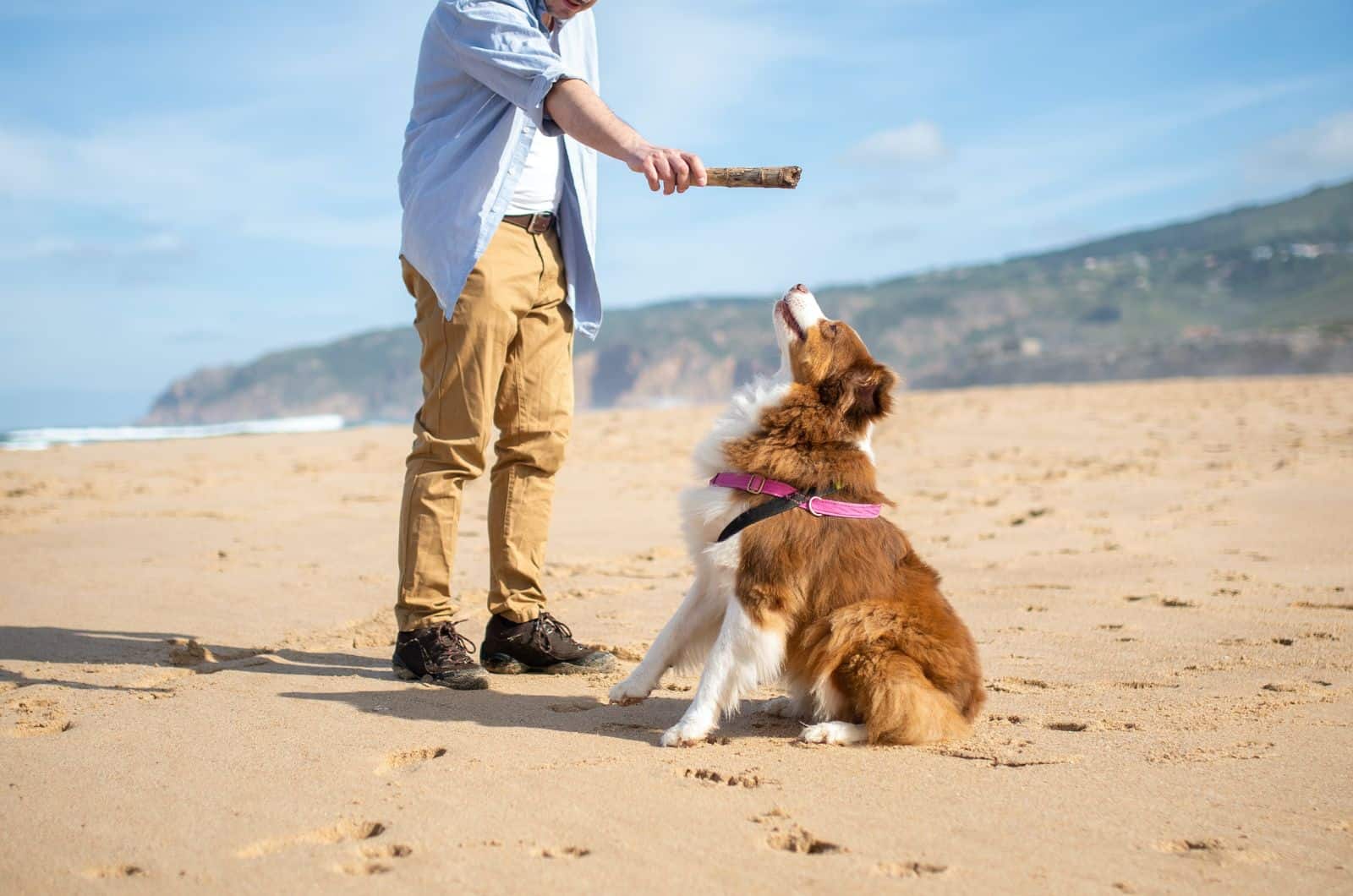
The prey drive, otherwise known as the hunting instinct left over from their wolf ancestors, was something humans of prior eras deemed as useful and sought to domesticate these fine animals into the pets we know today.
While the process certainly wasn’t done with a stick alone, it was part of what helped keep said instinct sharp.
So, they played a game of fetch, or several, which then translated into the games we do today for a similar reason, albeit more tame as opposed to hunting game for survival.
4. It’s A Prize To Show Off To You
When a dog finds an incredibly interesting stick, or one that he deems interesting, he’ll grab it to just show it off to you.
While, to us, that may not seem like much, it’s essentially an offering, a sign of respect and adoration toward his pet parent.
It may have some distinct smell, or taste, or some other benefit that they’d want to share with us, but all we really see is a piece of wood and the rest is otherwise indistinguishable to our senses.
5. Dental Benefits
If you see a dog chew on a stick, it may also be to try and soothe his sore gums, or, if he’s younger, to solve teething aches.
The texture of the stick can also help clean his teeth otherwise, making it nature’s very own toothbrush for them as they gnaw into it to scrape any food remnants off his pearly whites.
6. The Taste And Smell
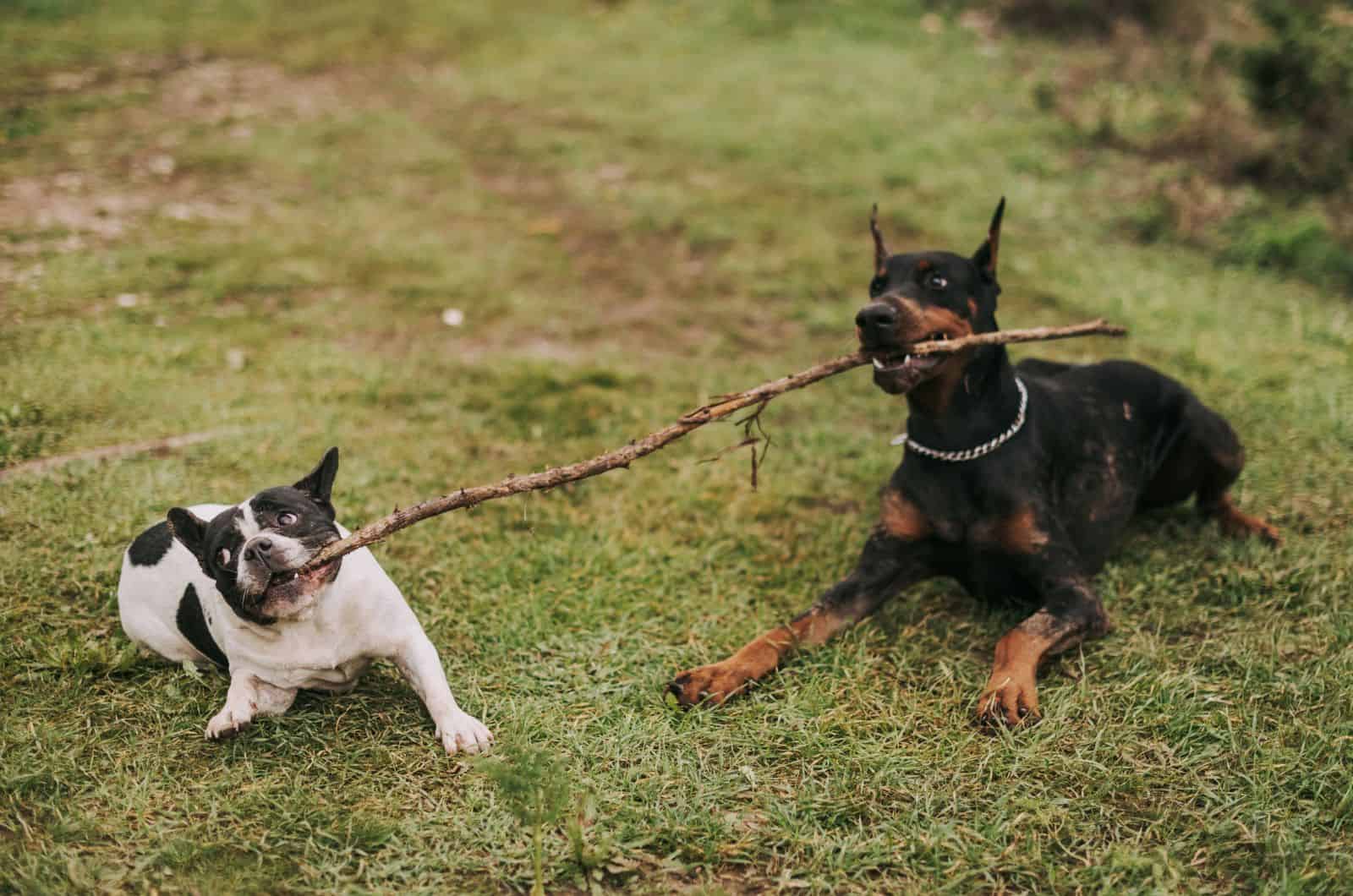
Dog’s have well over 300 million olfactory receptors, a lot more than us humans, which allow them to have a richer, and more precise sense of taste and smell.
Your dog is tasting something on the stick that you wouldn’t be able to do and they’re treating it as a type of snack, at least until they get that taste out as they normally won’t be trying to devour the stick itself.
The same goes with the smells. Maybe it has a lingering smell of petrichor on it or a distinct smell of some bacteria which is attractive and appealing to your canine companion which is why he chose a particular stick.
7. A Sign Of A Nutritional Deficiency
You’ve likely had your dog eat random stuff at one point or another like dog or cat poop, dirt, grass or pica. Sticks also fall under that category.
The reason why is commonly believed to be due to a nutritional deficiency from improper dieting or other issues like parasites or an underlying health problem, likely tied to the gut.
Pregnant dogs may do it too if their food intake wasn’t adjusted for their upcoming litter as well.
Should you see your dog do this, make sure to adjust his daily food intake accordingly or attempt swapping out brands for something with more nutrition.
Alternatively, a visit to the local vet would be best to determine if that really is the case.
Of course, chewing on sticks can’t be the only cause, and will usually be followed up with lethargic behavior, which is the real trigger for a check-up for any of these potential culprits.
8. Dogs Are Natural Foragers
Going off of the earlier mention about dogs liking sticks for their taste, is their interest in foraging which, once again, comes from their ancestors.
Even when turned into domesticated animals, dogs still prefer to find food in new places rather than it being brought to them all the time.
The behavior is dubbed contra freeloading by animal behaviorists and applies to sticks in this case too, not just food.
This is why your dog may be more likely to enjoy the new stick he just found over the new ball you just got him.
9. They Love To Bury Them
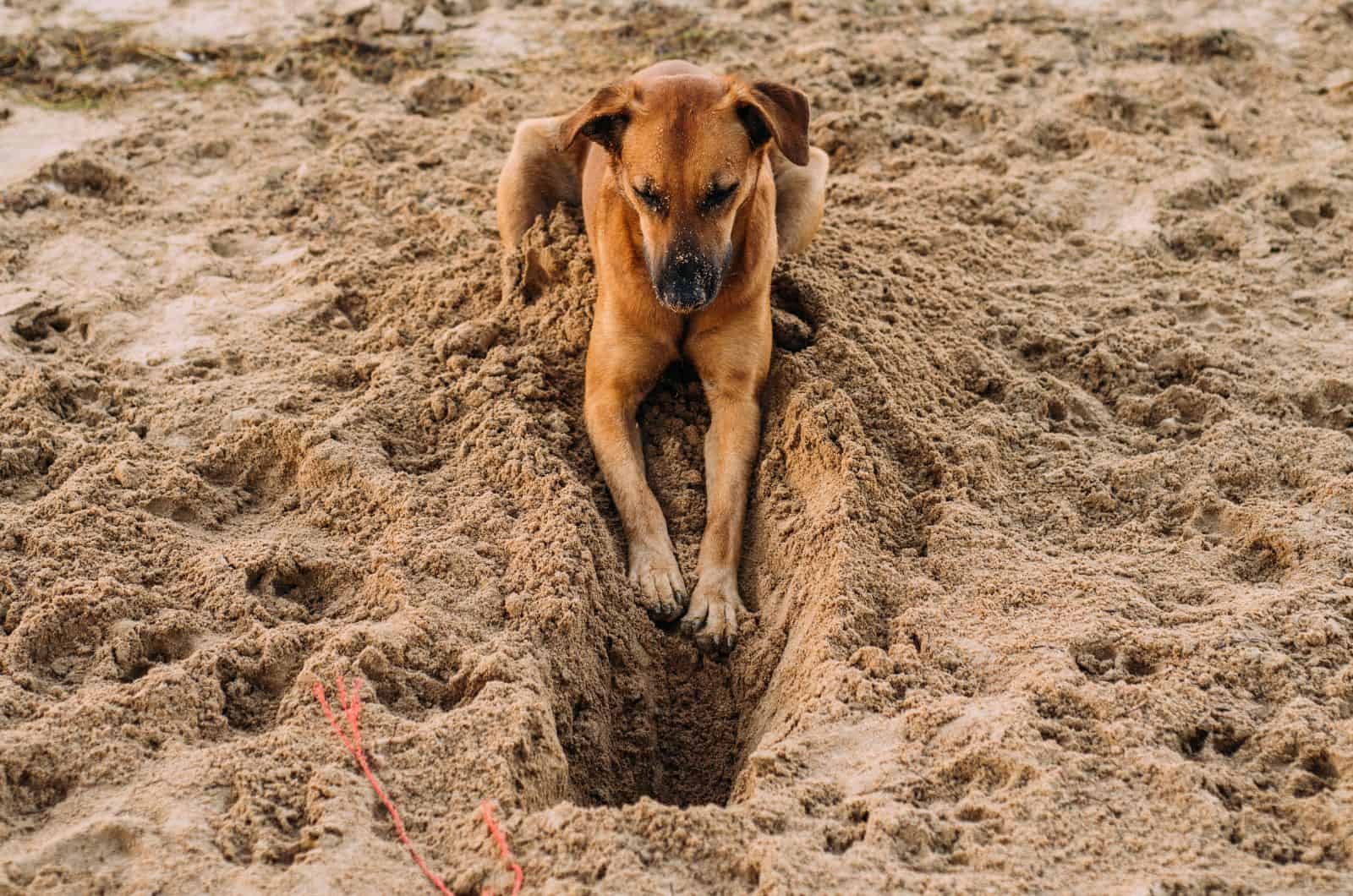
While this applies to a lot of things you give to a dog, they have this built-in burying behavior where they like burying bones in the ground to store them for later when they’re feeling hungry.
And, given how sticks share a similar texture to that of bone, your dog will end up taking an interest in them and their currently unique taste, and will bury them for ‘later use’.
10. Trained To “Kill”
While the act of killing would mostly translate to prey for a hunting dog, it’s kind of the same in the case of the stick which is why you may see your dog not particularly being keen on dropping said stick until it has been sufficiently damaged.
It’s one of the main drives of hunting dogs toward liking sticks, while most other dog breeds do it simply because they’re bored.
Are There Any Dangers To Playing With Sticks?
But, of course. Dogs aren’t really being careful when they run up to you with their newfound trophies.
Depending on their size and structure, sticks can cause a variety of problems, here are some of the more common ones.
1. They’re Prone To Breaking
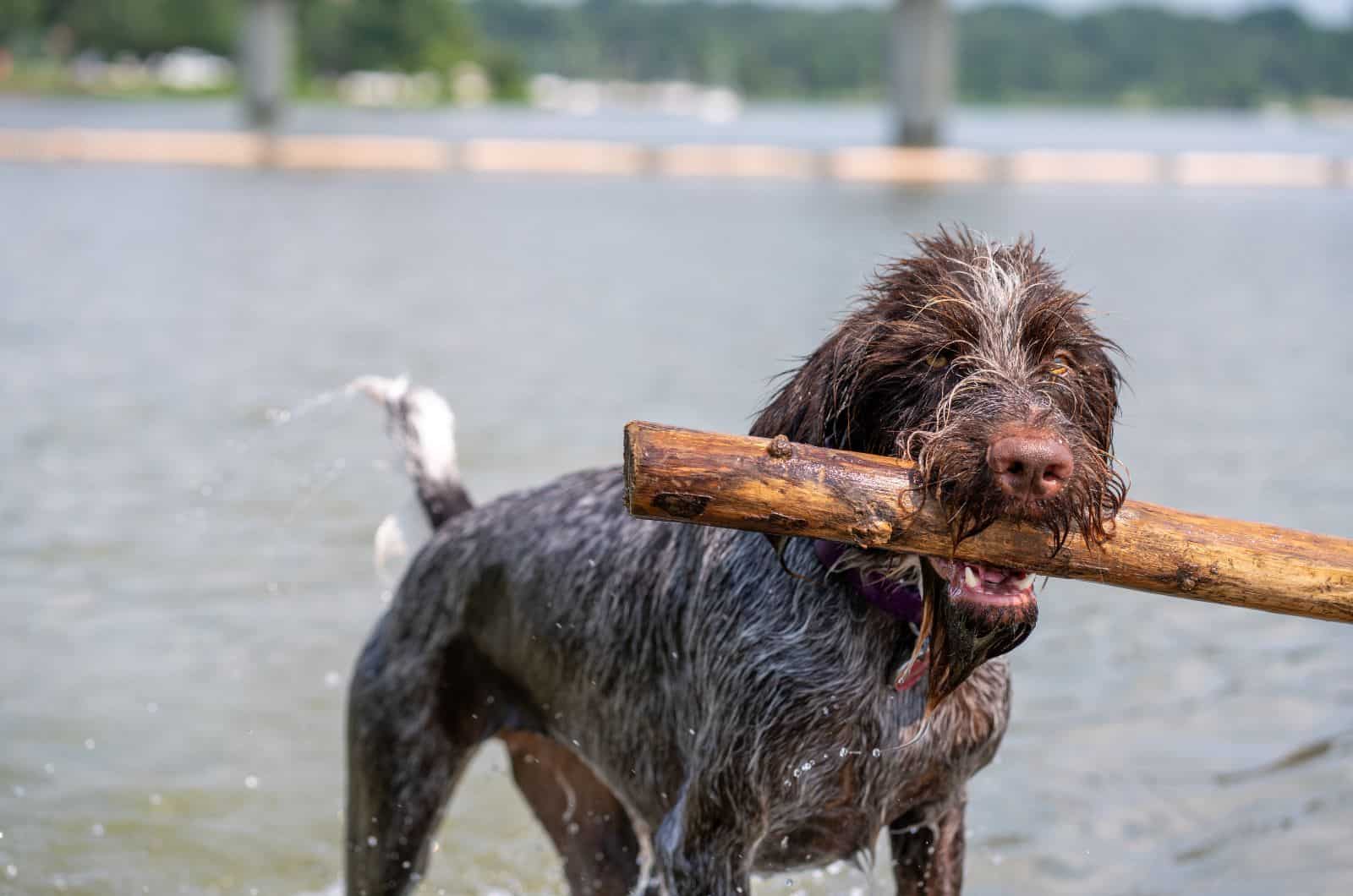
A pretty obvious case for stick danger is how many of them have different textures. The good ones are hard and sturdy, great to chew on and to play with.
However, plenty of them are often dry and brittle, prone to breaking and splintering from the force of your dog’s bite, and splinters are the worst thing to have to deal with, especially if one gets lodged in your doggo’s mouth.
They’re one of the more common injuries you’ll encounter and they can be a real nuisance, leaving affected areas more prone to infection and often needing a pair of tweezers to get the whole mess out if one really gets in there.
However, if it does end up somewhere in his mouth, you’ll more than likely need to call a vet to do it as there’s no way your canine companion is staying put when he’s in pain, so you’ll need a professional’s help.
2. Your Dog Can Swallow Them
Other than the pieces getting stuck in your dog’s mouth, they can also end up getting swallowed.
This, oftentimes, is even worse and can end up causing some serious damage to his intestines and may require immediate medical attention to not make matters worse.
If ingestion ends up being the case and the stick shard goes all the way over to the digestive tract, expect that your dog will need surgery as the shard is likely irritating his bowels or has gotten stuck deeper down in there.
It could’ve also damaged the lining and caused internal bleeding which is even worse in some degree, and all of these are going to require surgical procedures to help remove the stick from your darling doggo’s intestines.
3. Your Dog Can Choke On Them
The other possibility is that the stick or pieces of the stick get stuck in the dog’s esophagus after getting swallowed, making him choke.
Now, I doubt you need me to tell you how dangerous anyone choking is, as it can quickly turn fatal, but I’m sure you’re confused on what you can do to help a choking dog.
It’s simple, you do the same you’d do for a human, the Heimlich maneuver.
For this one, you’ll want to do a few distinct steps:
You’ll want to hold him up by his back paws to turn him somewhat upside down, like a wheelbarrow so gravity can help make dislodging the stick easier.
Once that’s done, you’ll want to move your hands over to his abdomen while keeping him up with your body, then squeeze tightly a few times to hopefully make the stick give a little and slide toward the entrance of the dog’s maw.
Then, you’ll want to sweep the inside of his mouth with a finger quickly to help prompt the foreign object out further.
And, finally, you’ll want to get him standing back up, then hit him between the shoulder blades with a few decisive taps and that should hopefully do the trick.
Regardless of whether or not it worked, you should take him to a vet immediately as there’s a high likelihood that some damage was done to his throat or elsewhere.
If you didn’t manage to pull it out, then your vet should be able to handle it and help your dog recover properly as well.
Do be wary that your dog may lose consciousness during the process too due to lack of oxygen and depending on the severity of the blockage.
It’s relatively standard though, so don’t get too scared and keep a level head, your dog’s life may depend on it.
4. He Can Break His Teeth On Particularly Sturdy Ones
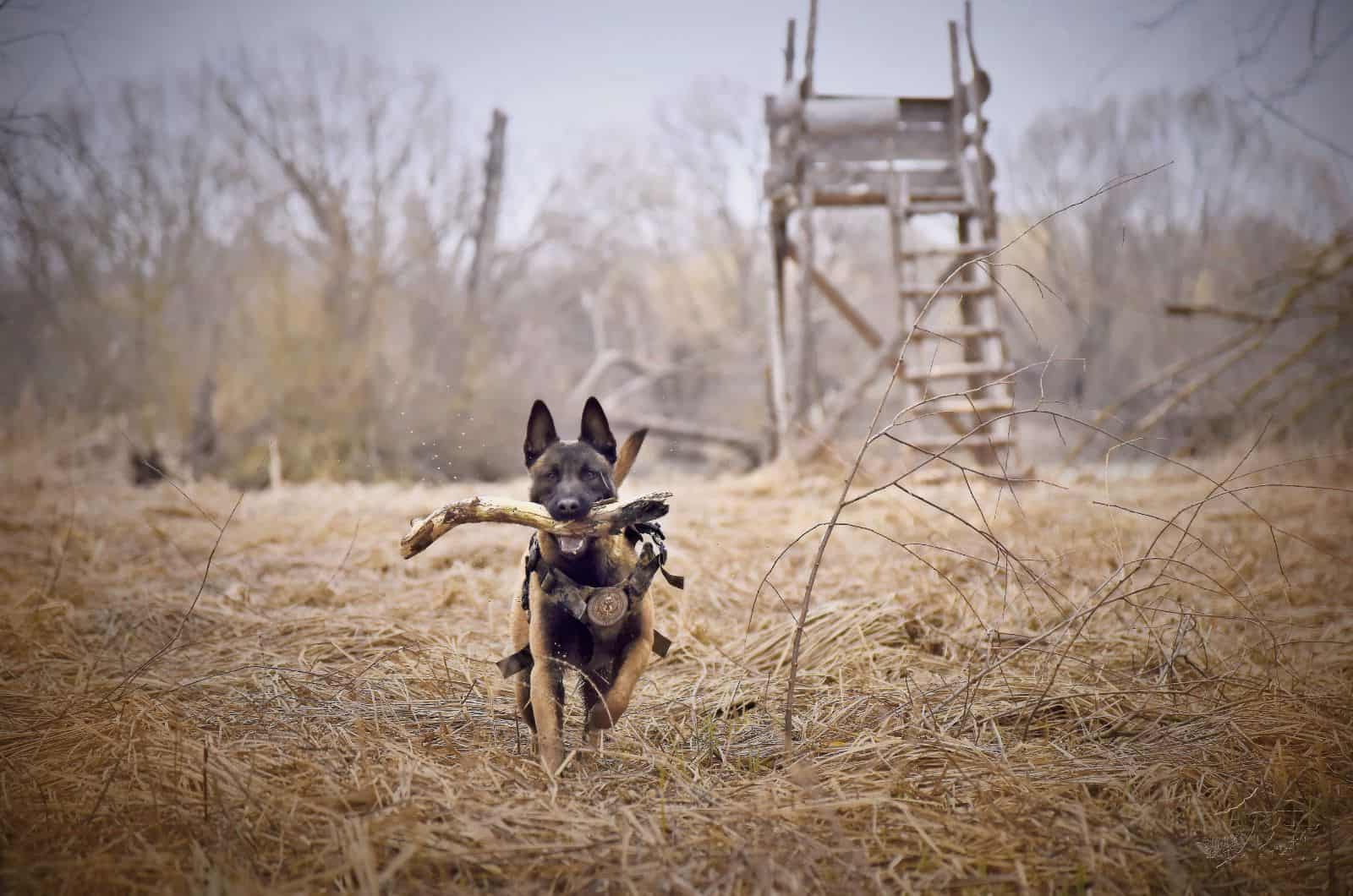
Another potential danger, albeit nowhere near as lethal, can be broken teeth from your own dog being too persistent and applying too much force on a very stubborn stick that doesn’t want to break.
It’s not too rare that the dog busts a few teeth up by gnawing down on some random piece of wood that he finds which’ll cause him a great deal of pain.
Thankfully, it’s easy to notice even if you’re not present for the initial whine when the break occurs, but it’ll be clear if your dog refuses anyone to touch his mouth or the affected tooth.
Any apparent signs of pain that your dog normally exhibits should be there too alongside a constant drooling as the dog refuses to shut his maw fully to not apply pressure to the injured tooth.
You may also notice a distinct and inexplicable loss of appetite at first glance, mostly regarding dry dog food or treats, only choosing to eat the wet and mushy stuff or to drink water.
If left unnoticed for a while, it may also lead to drastic weight loss, which could spawn even further problems for your precious pooch.
If the break isn’t too severe and he still eats the harder stuff, then you may notice him twisting his head and opening his jaw in unusual ways and taking his sweet time with the food too which will be a clearer sign that something is off.
Finally, some of the more distinct signs will be blood in his drool or straight up bleeding if the break was severe enough to puncture the gums.
Should this happen, get him to a vet so he can determine the extent of the damage and so he can resolve the situation either himself or by recommending you to someone who specializes in veterinary dentistry to help fix the problem.
5. He Can Inhale The Shards
Something worse than getting the stick stuck inside his esophagus is the shards getting inhaled and going down into the respiratory tract, leading to infections of said respiratory tract which can then cause further damage to a lot of vital functions.
6. He Can End Up Poisoning Himself
Sticks are far away from being the cleanest objects on the planet, especially considering that most dogs go for them for their musky scents and various flavors.
Their defaults will often be fruit tree sticks for that specific reason, however, a good number of those are relatively toxic and can lead to an extremely upset stomach for your precious pooch.
The same can be said for a variety of other trees like red oak, red maple, yew, black cherry, black locus, and black walnut trees, to name a few.
That’s from the sticks alone, but there can also be a number of bacteria that have wound up on the surface of the stick which, when ingested, are going to get your dog severely ill or may lead to an infection of some kind.
It’s one of the more common ways dogs earn themselves a stomach parasite aside from uncooked meat.
Fungus is a pretty common find on sticks too, and ingesting or inhaling some of the more dangerous varieties can be extremely detrimental to your doggo’s health.
7. He Can Impale Himself On Accident
Finally, impalement is one other relatively common injury among dogs when playing around with sticks.
It may sound drastic, but it’s not as bad as some of the other potential dangers on this list, most of the time.
This mostly happens when they chew on sticks and they splinter off into bigger pieces, ones that don’t get stuck like the smaller ones would, but make a bigger gash, wounding the inside of his mouth.
However, they could actually get impaled if they’re carrying a stick and end up tripping over onto it or something, that part is a lot more life threatening than most of the ones that cause mouth injury.
Regardless, both will require veterinary attention.
The main thing that you should remember to do is to NOT TAKE THE STICK OUT, especially if the puncture wound is too large.
Removing it is like unplugging a bottle, except this one can’t be plugged back and will cause constant bleeding which could mount up to a case of severe blood loss which is in no way ideal.
Make sure your dog doesn’t end up doing anything to it either.
If you can, secure the stick as best you can and your dog too so it doesn’t move around too much.
If possible, ask for a house visit and further instructions on what you can do until help arrives.
If not, then see if you can saw or break off the stick if it’s too long while still keeping the impaled part inside if it’s not near any vital areas.
Whatever the case may be, take no further action unless instructed by the vet as he’ll be the one to resolve the situation, often through surgery for the more severe cases.
If you’re only looking at something relatively mild, it’ll be a lot safer to transport him, but it still won’t be too safe to extract the stick that impaled him, unless the vet says otherwise.
Why Do Dogs Chew On Sticks In The First Place?
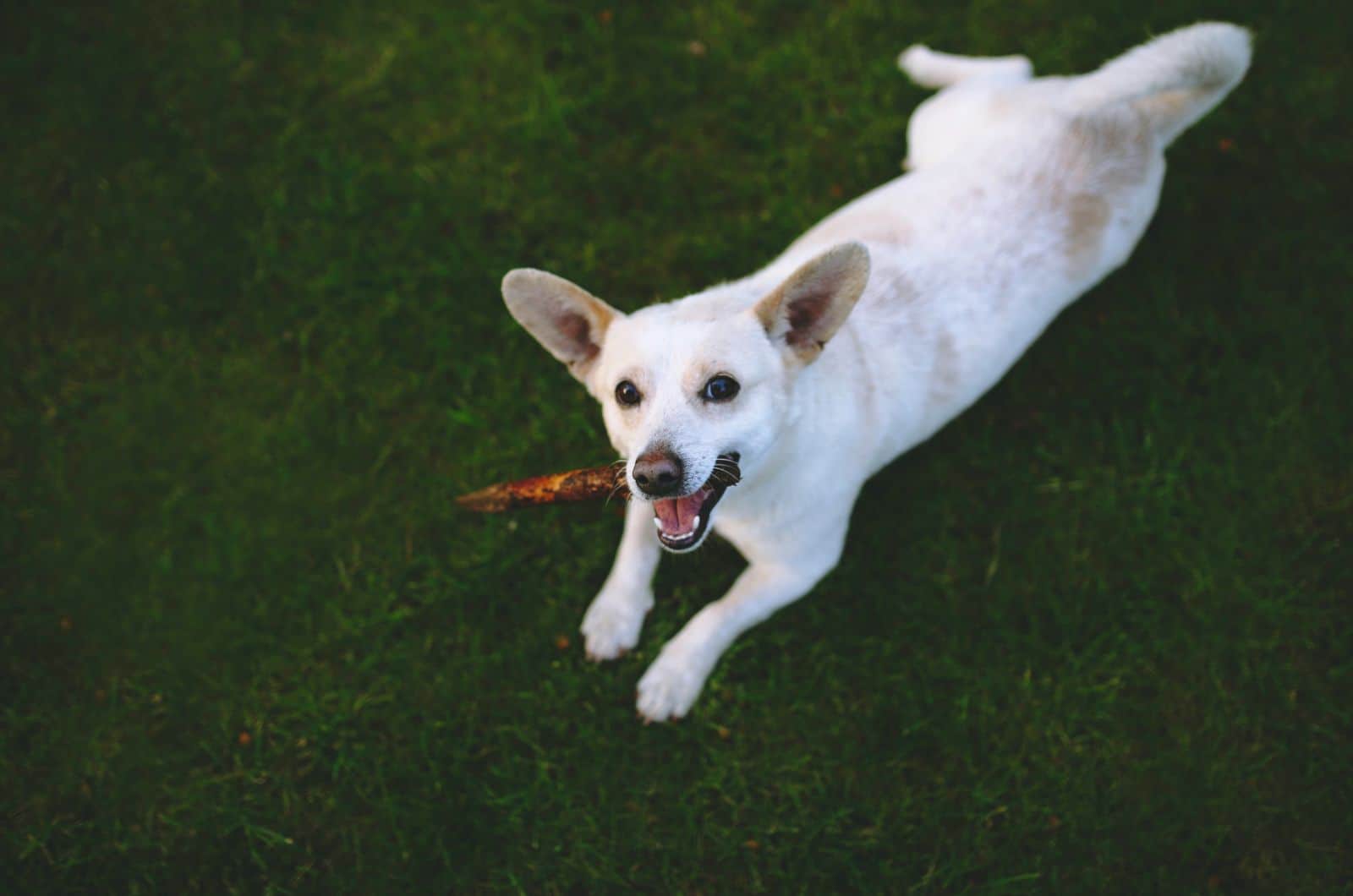
Well, there are two different major reasons as to why dogs even chew on sticks to begin with.
The first one is simply because they’re bored and want something to occupy their time with, much like they do with toys nowadays,
The other is due to the aforementioned prey drive, the hunting instinct that they possess to go out there to catch and retrieve the prey and return it back to you.
Different dog breeds do it for different reasons, and here are a few good dog breed examples for each category to give you a better idea on which of them do it for which reason:
Chewing Sticks Out Of Boredom
- German Shepherds
- Huskies
- Australian Cattle Dogs
- Border Collies
- Poodles
- Dalmatians
- Australian Shepherds
- Corgis
- Shelties
- English Springer Spaniels
Chewing Sticks Because Of A Hunting Instinct
- Weimaraners
- Irish Setters
- Boston Terriers
- Jack Russel Terriers
- Labradors
- Yorkshire Terriers
- Pointer dogs
- Bull Terriers
- Beagles
- Golden Retrievers
How Do Dogs Injure Themselves With Sticks Anyway?
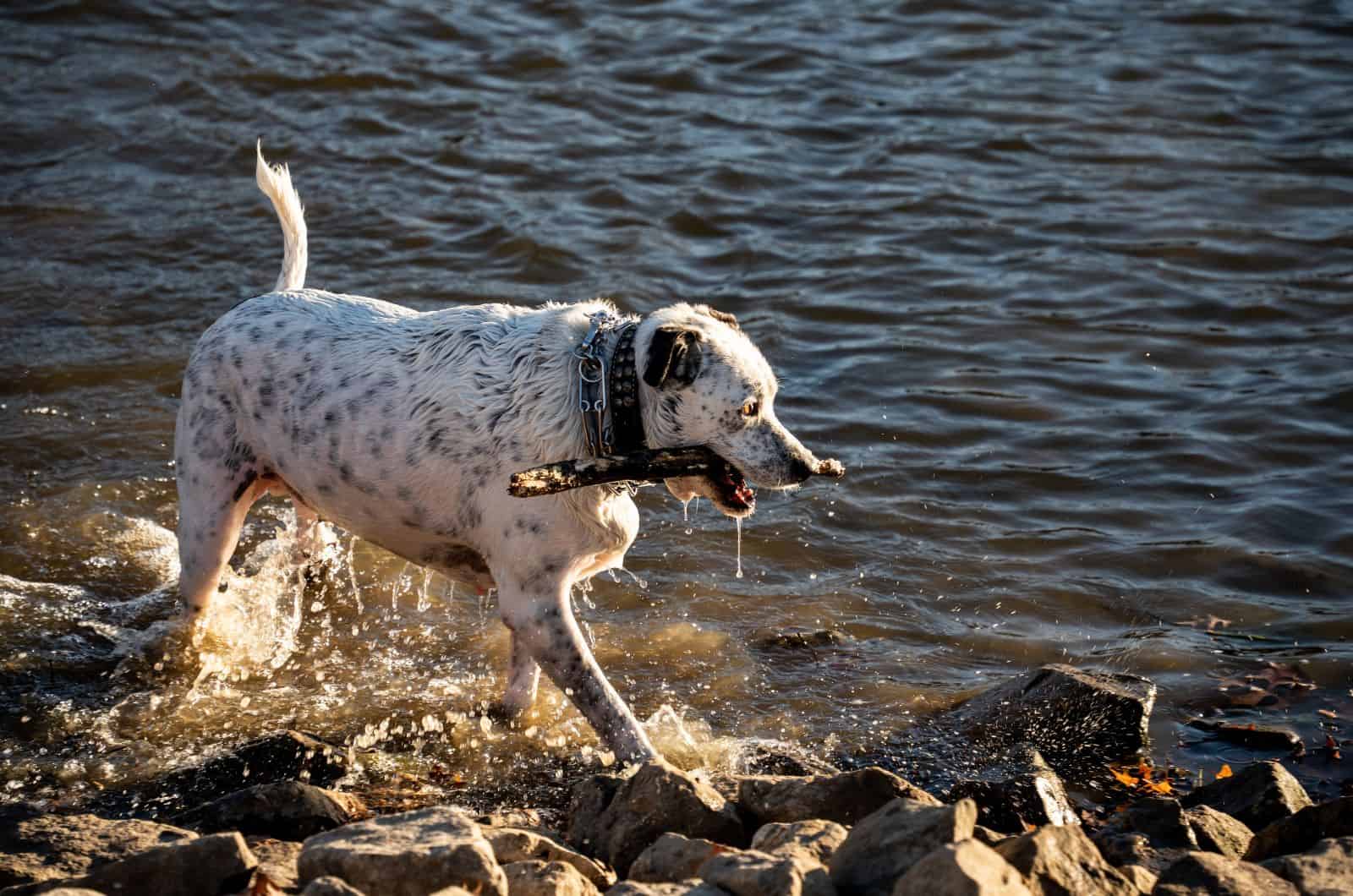
Dogs are eager creatures, so much so that they don’t end up looking where they’re going so they end up slipping or hitting against something.
It takes only a moment of carelessness for that stick that’s being carried to get dropped and impale your dog in an unpleasant way that’ll end up requiring medical attention before anything more serious develops out of it.
The less severe injuries happen through stick chewing and most of those can be handled at home, but impalement to a more severe degree is definitely something that falls on the vet’s hands to fix.
Can Sticks Be Replaced In Any Way?
Of course they can, there are plenty of alternatives out there which are safer for your dog in every way and which can fulfill the benefits that the stick would provide otherwise.
Sure, it’s still a useful tool and has been for eons, but there are clear dangers to using them which, no matter how rare, are still a possibility and would thus need to be handled properly, which isn’t always possible.
1. Chew Toys
The number one and most durable option will be chew toys, as well as fetch toys depending on how the stick is used.
The former is simply safer for the dog as it’s made from durable material that won’t splinter and cause the many issues that a stick would if that were to happen to it.
Chew toys are often softer and more colorful, made to foster more interest in themselves by their very nature and won’t cause your dog severe injury should he trip with them. A bruise, maybe, but nothing more serious than that.
And if taste was a concern, you could always find ones that have a taste to them, like one of the Nylabone chew bone toy options, for example.
With everything else, they’re simply the superior option as long as they’re made from non-toxic material themselves.
Fetch toys fulfill the other niche, they’re meant to be fetched, but they often don’t have the awkward shape that a stick does which makes carrying them back relatively dangerous.
Often shaped like balls or frisbees, all made from, again, material that’s both non-toxic and safer to impact into, yet durable to canine jaws, and colored in vibrant colors or possessing some other gimmicks, they’re the better choice between the two.
Obviously, this alternative costs money, but it’s not that much in the long run, and it’s better than a stick in most cases.
2. Bones
The other alternative are bones. While bones themselves aren’t all that safe in regards to splintering, they’re definitely sturdier than sticks are, despite what the famous saying claims.
They’re also more nutritious and your dog will take even more of a liking to them if they have bits of meat stuck to them, just be sure to give them a quick boil to eliminate any potential bacteria that may linger in it.
You can’t exactly play fetch with them like you would be able to with a stick, but they’re great if you need to occupy your dog’s time as they’re going to be busy gnawing off what they can off that nice and juicy bone you’ve given them.
They may even end up burying it for later use, who knows.
Whatever you end up choosing, they’re both great ways to get your dog to stop going after sticks that could potentially harm him.
Are Sticks Really That Dangerous?
Well, despite all of the dangers mentioned here, the more dangerous injuries are relatively rare.
You’ll get the odd bleeding or splintered mouth alongside a broken tooth, or an impaled mouth roof, but nothing more than that.
As long as you supervise your dog, the chances of anything worse occurring should be minimal.
The whole intoxication bit too is easy to avoid as long as you check the stick for any odd growths or foreign objects and make sure it’s not from a particularly dangerous tree.
But, the worst that can happen if it is, would be a mildly upset stomach, if the tree is the only thing in question.
So, sticks are still useful in their own right and a great option to go for when you want to play fetch with your furry friend, but the alternatives are ultimately better for his health.
In Conclusion
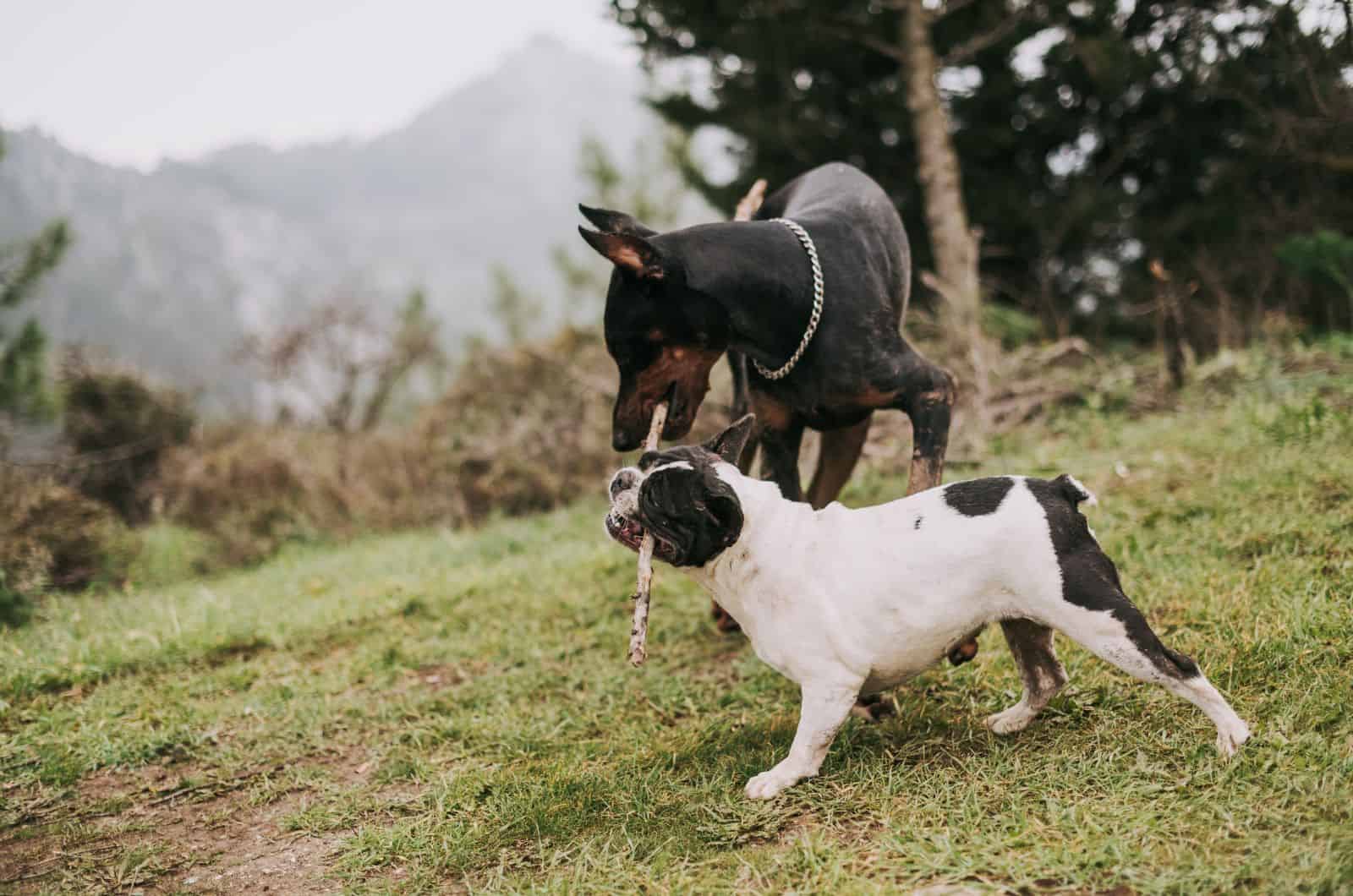
So, why do dogs like sticks? Well it’s safe to say that it’s something we’ve built into them ages ago when we first domesticated them, using the sticks to foster their natural prey drive to serve our own ends to help hunt down prey and bring it back to us.
Aside from the purposes of hunting, sticks were one of the very first dog toys back in the day when any other form of toy wasn’t all too abundant, or was too expensive to obtain.
That’s why people made do with what they had and the stick became the quintessential entertainment tool.
Over time, that has shifted away due to the availability of the many toys we have now as well as other forms of entertainment, but also, in great part due to the hazards that the sticks posed.
While they weren’t all that prevalent, they were still a present danger and alternatives needed to be made.
Whether or not you decide to keep using sticks for fetch or for your dog to chew is ultimately up to you.
The risk is there, but is manageable through behavior training and supervision. I trust that you’ll make the right choice for your canine companion. Until next time, pet parents.
RELATED LINKS:
- Why Do Dogs Rub Their Face? Find Out 11 Possible Reasons
- Why Do Dogs Like Socks? 7 Reasons And Tips For Prevention
- 8 Puppy Teething Symptoms Every Dog Owner Should Know
- Why Is My Dog Acting Weird All Of A Sudden: 10 Causes
- Why Does My Dog Cry When Carrying Toys? 12 Possible Reasons
- Why My Dog Won’t Eat His Food But Will Eat Treats?
- Why Does My Dog Eat My Underwear? 12 Reasons And 7 Solutions
- Why Does My Dog Nibble On Me? Dog Mouthing Behavior Explained
- Why Does My Dog Suck On Blankets?
